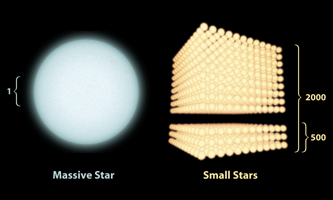
Annotated Version
Click on the image for larger versionThis diagram illustrates the extent to which astronomers have been underestimating the proportion of small to big stars in certain galaxies. Data from NASA's Galaxy Evolution Explorer spacecraft and the Cerro Tololo Inter-American Observatory in Chile have shown that, in some cases, there can be as many as four times more small stars compared to large ones.
In the diagram, a massive blue star is shown next to a stack of lighter, yellow stars. These big blue stars are three to 20 times more massive than our sun, while the smaller stars are typically about the same mass as the sun or smaller. Before the Galaxy Evolution Explorer study, astronomers assumed there were 500 small stars for every massive one (lower stack on right). The new observations reveal that, in certain galaxies, this estimation is off by a factor of four; for every massive star, there could be as many as 2,000 small counterparts (entire stack on right).

